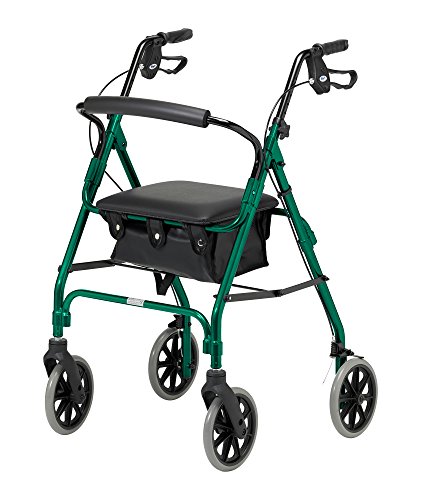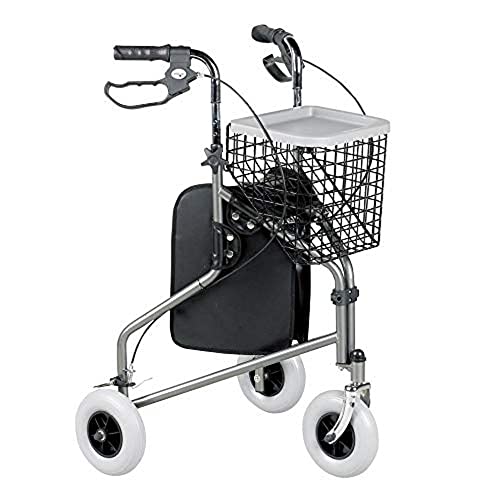Community
커뮤니티| How To Tell If You're Ready For Rollator Mobility Walker(37.143.62.93) | |||||
| 작성자 | Lydia Newdegate | 작성일 | 24-09-05 18:51 | 조회 | 581 |
|---|---|---|---|---|---|
관련링크 Rollator Mobility Walker Rollator Mobility WalkerRollators are a good option for people with limited mobility who need stability while walking. They come with big wheels that have a space built into the frame for seating.  This model features padded handles to provide the user with comfort and reduce pressure on their hands. It comes with adjustable handlebars that can be adjusted in height and intuitive loop locks that prevent the walker from moving when you're resting or sitting. This model features padded handles to provide the user with comfort and reduce pressure on their hands. It comes with adjustable handlebars that can be adjusted in height and intuitive loop locks that prevent the walker from moving when you're resting or sitting.Comfort If someone has suffered an injury that affects their balance and gait or recovering from hip, knee, or other lower-limb surgeries, or injuries, a rollator mobility walker can aid. These walking aids provide stability and support, allowing users to walk more comfortably while allowing them to remain active and connected with their family, friends and community. They come in a variety of forms, including a traditional walker with no wheels and looks much plainer than the rollator. Walkers typically have handles that are placed at a level that is comfortable for the user, which makes them ideal for those who needs stable support but still would like to be able move more easily than with a cane. The wheels on a rolling walker make it more flexible and easier to use than a standard walking device. The wheels on a all terrain rollator uk are more to each other, making it easier to maneuver and control the device in tight spots. They can also be swiveled to improve agility when going up and down the stairs. Many rollators for tall person have a seat with a crossbar so that users can sit down whenever required. Handles for rollators can be constructed of materials that differ in texture and thickness. Look for handles that have a soft texture and a soft plastic grip. It is more comfortable to hold for people with arthritis. Consider whether the device has loop-lock brakes or lean-activated brakes to accommodate different hand strengths. Stability A good rollator walker should have a wide and comfortable seating area for people to sit on when they need a break from walking. It should have easy-to-operate brakes and soft, ergonomic grips. The grips must be cushioned and comfortable for people with wrist or hand problems. Some models include a padded backrest to provide additional support. You should choose a walker with an ability to carry a load sufficient for your needs and adjustable handles to fit your height. A locking mechanism on a walker is essential for those who travel often or require transporting the walker in and out of their vehicle. It can help prevent the walker from being accidentally opened during transport, preventing injuries and other harm. Consider whether the walker is adaptable to your requirements with interchangeable and removable components. Researchers conducted a study to determine how the strategy for task-performance, and the device load impact rollator stability. Ten participants took on six tasks using a rolling cane that was instrumented. The team measured system Stability Margin, which is the combined pressure at the centre and the support base. They found that SM decreases significantly from straight line walking to other activities. They also found that leaning on the device increases the centre of pressure at the base of support. This can alter stability or increase it. The researchers conclude that their findings can be used to improve rollator training. They suggest that more focus should be put on other activities that are not straight line walking, and on specific strategies for each activity that may facilitate or hinder stability. Capacity for weight-bearing A rollator walker can be capable of supporting up to 300 pounds or more depending on the model. Its robust frame and four wheels aid in maintaining mobility and balance, especially for individuals with medical conditions or who are aging. Rollators are easier to maneuver than walkers with standard features that require users to lift their weight in order to move forward. This reduces hand fatigue. Rollators have wheels that range from between 6 and 10 inches wide. This allows them to be used indoors and outdoors on various surfaces. Some models feature a range of height settings to accommodate different users. Some models fold up rollator up to make it easy to transport chair rollator and store. Some models even have a seat for users to rest while walking. Many walkers come with a range of accessories. For example a tray for walker or basket to store personal things. A wrist guard is provided to protect your hands from injury and bags for walker's use to carry additional belongings. Some walker frames are also compatible with wheelchairs, making them simple to adapt when mobility needs change. A bariatric rollator is designed with a heavy duty frame and wider seat to accommodate larger people. It comes with adjustable height handles and a wide padded backrest, as well as hand brakes that are locked to ensure the maximum security and safety. The angled handle bars position the hands in a neutral place to avoid fatigue and stress and fatigue, while the convenient storage strap allows it to be easily tucked into a vehicle's trunk. Its sturdy 8" wheels are fitted with anti-tip technology for greater stability and maneuverability, and the padded seat provides a comfortable way to rest when you're on the move. Brakes A rollator is different from a typical walker. The wheels of a rollator can be controlled independently by hand brakes that are integrated or placed beneath the handlebars. This design allows you to maneuver through tight spaces and to make sharp turns left and right. The brakes can become hard to operate or loose, which could be a risk to those with limited strength and declining mobility. Many manufacturers offer the option of adding brakes that can also be locked to improve safety and stability. This feature is especially beneficial for individuals who may be unable to squeeze or apply pressure to the brakes because of an insufficient grip or other medical conditions like arthritis. There are some variations in the method that locking brakes are set up, however most walkers use the same steps to ensure they are correctly adjusted. It is essential to read the maintenance instructions that come with your mobility device to get specific instructions before you attempt to adjust the lock brakes. To begin, locate the adjustment screw for brakes or knob which is usually close to the grips on the handle. Make sure to tighten it by rotating clockwise. This step is crucial since if you do not tighten the adjuster in the correct way it will be difficult to remove the slack in the brake cable. Then, tighten the lower cable adjuster with the same method. After you have completed these adjustments, test the brakes by squeezing them gently to see whether they respond in a timely manner. If they don't, the locking mechanism is probably not working properly. Accessories A number of accessories are available for walkers on rollators, including cups and baskets. Some accessories are designed to carry things while walking, and others, like the Mobility Phone Grip clip onto the bars on the vertical sides of the walker or wheelchair, and expand to hold the smartphone. The grips can also be adjusted to the perfect height to hold your device. Many of these accessories are designed to be lightweight rollator transport chair, easy to use and ideal for people with arthritis. Most manufacturers of walker and rollator offer a variety of handle sizes, so you can choose the best one for your body type. Take into consideration the weight capacity when you choose a rollator. This will impact the way it performs for you. While the majority of models are designed to support those who weigh between 300 and 300 pounds, some manufacturers have bariatric versions that can support up to 500 pounds. When you are choosing a walker or all terrain rollator, it is important to also consider the brakes you will use. Push down brakes function by putting downward pressure on the frame to stop forward movement. Loop brakes are similar, however they require the use of both hands and more physical strength to apply. Both kinds of brakes are a vital safety feature, and it's important to find the best choice for your needs. If you're unsure what type of walker or rollator would be the right one for you, it's suggested that you talk to your physical therapist, doctor or occupational therapist. They can advise you about the features that are most beneficial to your particular situation, and help you choose a model that's compatible with any equipment you may have at home or in storage. |
|||||
